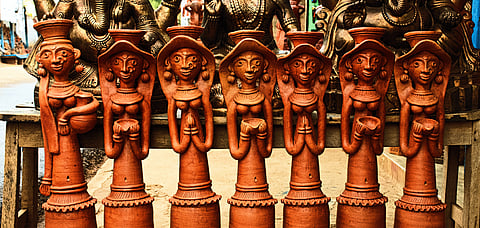

West Bengal is home to a variety of handicraft that are not only aesthetically appealing but also eco-friendly and representative of local history and culture. Yet these products are facing an uphill task in terms of survival, affected by rising costs of raw material, long drawn labour-intensive processes, and competition from mass produced machine made goods. Thankfully, interventions from government bodies and social welfare organisations have taught these artists to repurpose their art forms while retaining the original style, as well as to market them, which have given them a fresh lease of life.
Terracotta (Bishnupur)
When the Central Cottage Industries Emporium, founded in 1952, chose the &lsquoBankura Horse&rsquo as its logo, it lifted the little known terracotta art of West Bengal to global fame. Bishnupur, in Bankura district, about 200km west of Kolkata, is home to terracotta temples covered with intricately carved tiles depicting tales from Ramayana, Mahabharata, life of Krishna, etc. Apart from temples, artists used to fashion small toys for use in local religious ceremonies, such as Manasar Chaali (a votive object representing the snake goddess Manasa), horses with pointed ears, and elephants. As handcrafted ethnic products began to gain popularity, artists began to make these ritualistic objects as decorative pieces. Apart from animals, they began to make costume jewellery and other accessories, wall decorations, utility items such as pen holder, bowls and ash trays, etc. In winter, when Bishnupur receives the most tourists, the road side is choc a bloc with craft stalls. However, to see the artefacts being made, you have to visit Panchmura, about 20km by road from Bishnupur.

Dokra (Dariyapur)
Dokra (or Dhokra), an ancient form of non-ferrous metal casting using the lost-wax process, has been known to indigenous people of India since the Indus Valley Civilisation. It is believed that tribes in central India (now largely Chhattisgarh) were the practitioners of this art, which later spread to other regions of the country. Dariyapur in Purba Bardhhaman district, nearly 140km from Kolkata via Guskara, is home to a group of dokra artists, who, have been practising this art for nearly 120 years. The process of metal casting is a long drawn process. Artisans have to procure brass pieces for melting, which are not easy to come by. Besides, each object has to be made in its own mould, which is broken apart to retrieve the object. This makes each dokra item unique. Popular Dokra products include idols of Durga and Ganesh, elephants and other animals, human figurines, jewellery, utility items, etc.

Madur (Sabang)
Essentially, madur is a mat made by weaving a rhizome-based plant (madur kathi). It was a must at every traditional household, especially in the rural areas. It would be rolled up and kept in a corner of the room to be spread out as a floor covering to sit or sleep upon. Householders spreading out a madur to an arriving guest was a sign of being made welcome. An eco-friendly local craft from the former Midnapur district of West Bengal, it was on the verge of extinction until the artists were imparted training in making decorative and utility products, such as table runners and mats, purses and bags, curtains, holders, etc. Although the power loom has been introduced for weaving to keep prices competitive, head to Sabang in Paschim Medinipur district for its fine handmade mats called Masland or Mataranchi. Woven with specially prepared fine sticks and cotton threads, they are characterised by coloured patterns. Sabang and its surrounding villages are about four hours&rsquo drive from Kolkata. Banglanatakdot com (https://banglanatak.com/) has announced two festivals &ndash at Sabang (Dec 7-9, 2018) and at Digha (Jan 8-9) &ndash to promote the craft to a wide audience.
Chhau masks (Charida)
Along with Mayurbhanj in Odisha, and Seraikela and Kharsawan in Jharkhand, Purulia in West Bengal is known for its Chhau (also Chau) dance. What sets apart the Purulia style from others is the use of elaborate masks (smaller masks are used in Seraikela while the other two do not use masks). One of the best places to watch the making of masks is Charida (pronounced Chorida) village at the base of Ajodhya hill. Mask making is an elaborate process. Besides, they cannot be heavy yet have to last enough to stand the vigorous dancing, including somersaults and jumps. In simple terms, a mask is made of paper, cloth and clay on moulds made of mud then it is painted, varnished, and decorated with feathers, etc. Eye holes are made to allow the dancer to see. A mask is representative of the character a dancer portrays and hence there is a fixed colour scheme, such as Shiva is white, Durga is yellow, demons are black or green, etc. As Chhau performance is a seasonal affair, the mask makers now produce smaller mask for use as wall decorations. Charida is about 60km from Purulia town (which shares its name with the district). Purulia is connected to Kolkata by road (six to seven hours drive) and express trains. Banglanatakdot com has announced a Chhau Mask festival at Charida (Dec 14-16, 2018) in winter.

Hill craft (Darjeeling/Kalimpong)
Home to several indigenous hill tribes and influenced by the Tibetan school of Buddhism, the art and crafts of the Darjeeling hills are unique in their own ways. One of the items that make their way to the shopping list of most visitors are the painted scrolls or &lsquothangka&rsquo. You may also buy paintings by local artists, especially the ones depicting the Himalayas, the tea gardens and the local people, as keepsakes. The women are also expert in knitting woollen garments and shawls. The weekly market in Kalimpong is a good place to look for traditional garments worn by the local people. There are also products made of paper manufactured by using a local plant. Wood and bamboo carving is also practised by many.
